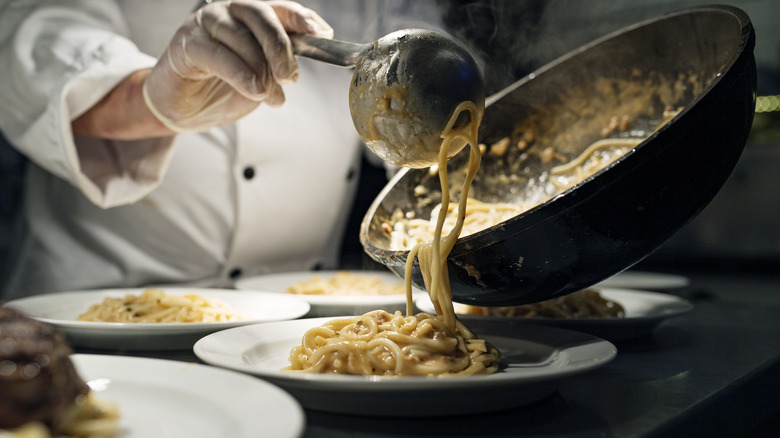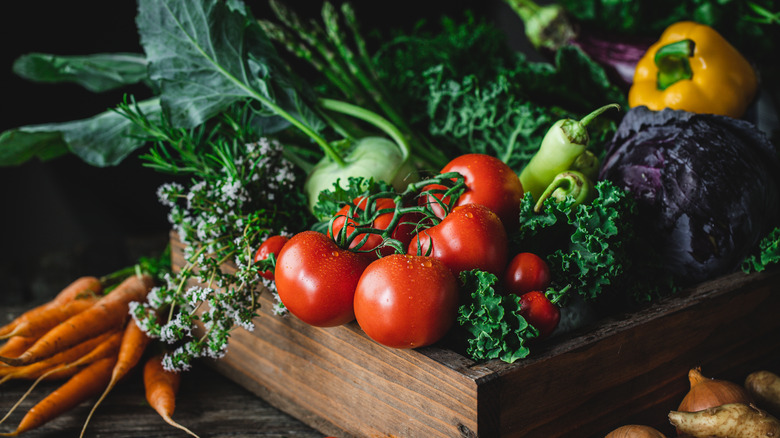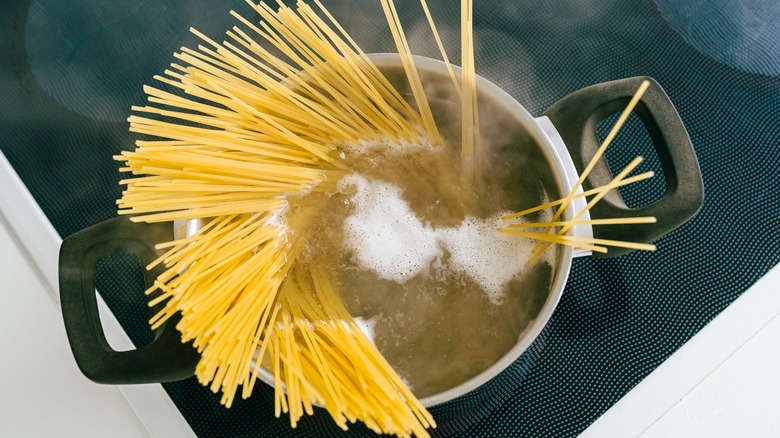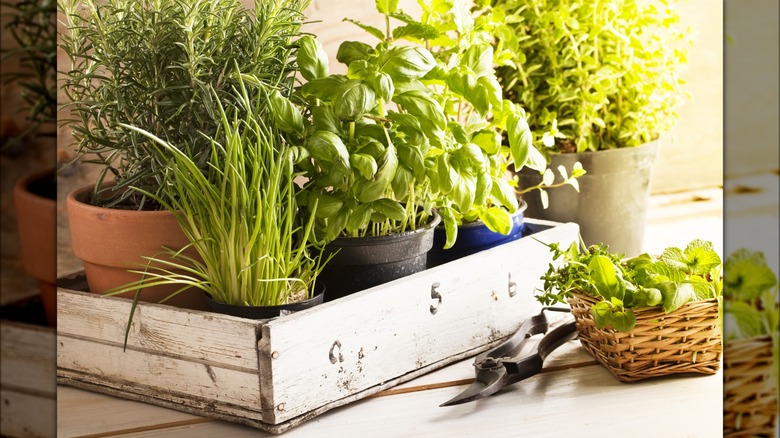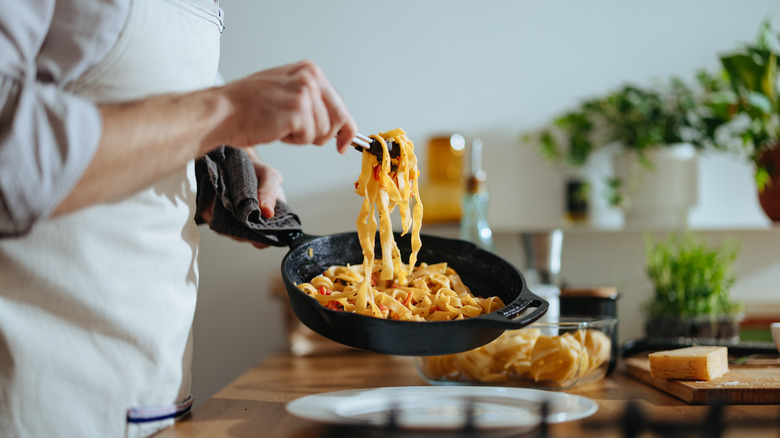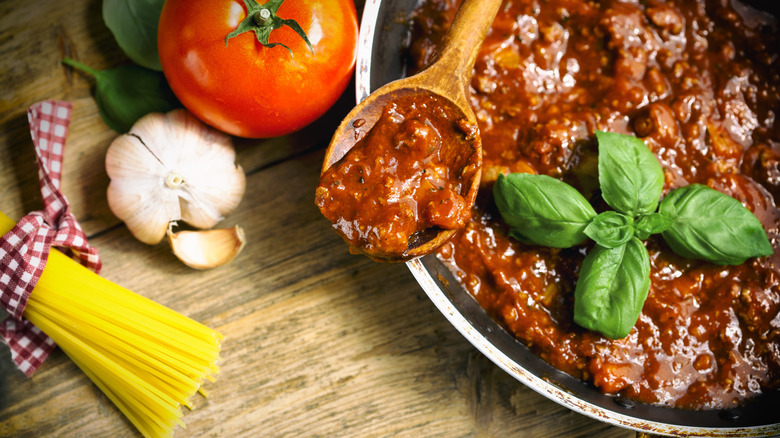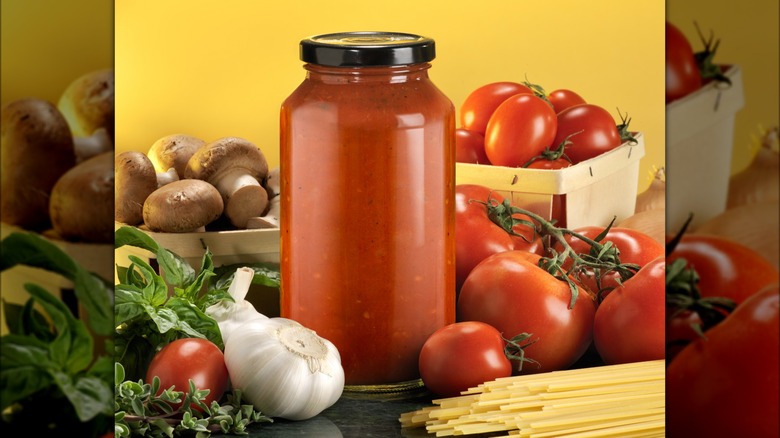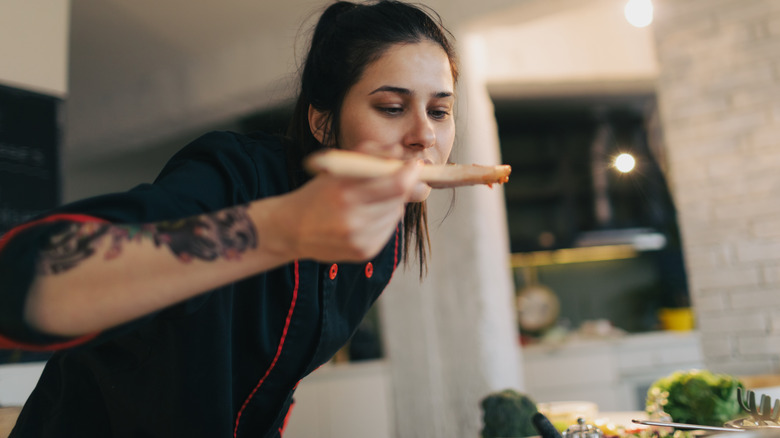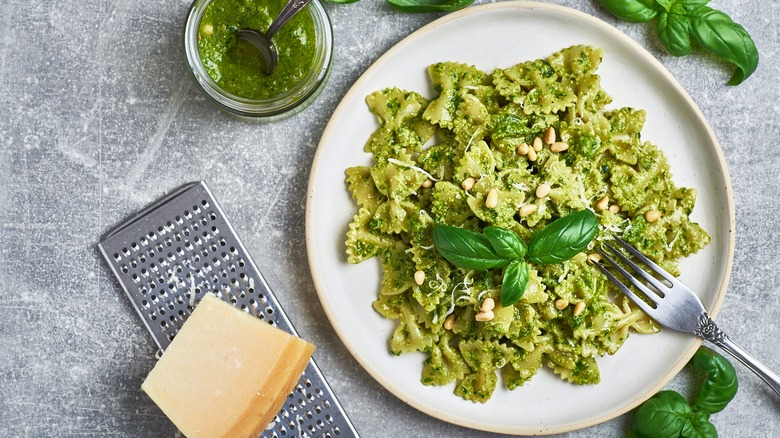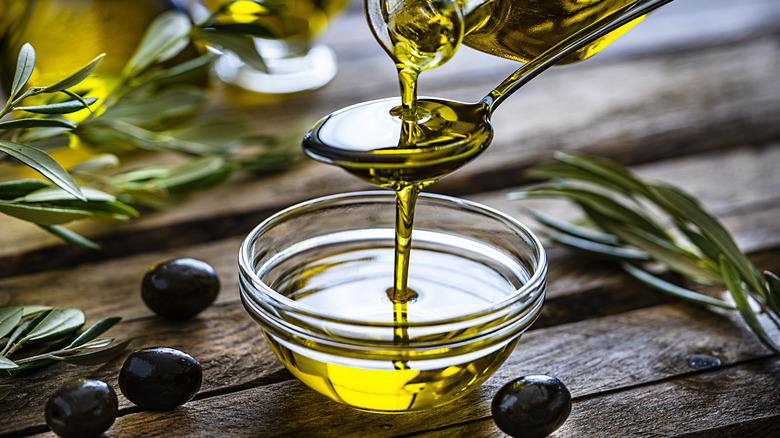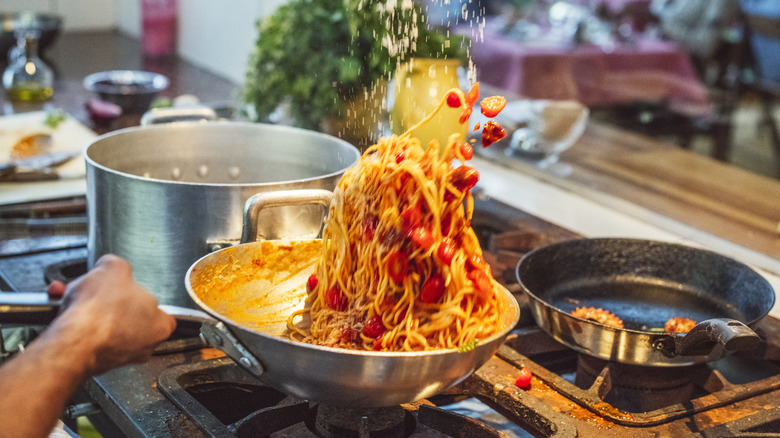10 Chef-Approved Tips For Making Perfect Pasta Dishes
Pasta may seem simple to make. But whipping up the sort of thing that would impress a real Italian nonna? Well, that's something different. Sure, many home cooks have no problems boiling a pot of water, throwing some noodles in (without breaking the spaghetti, of course!), and serving up a plate that tastes great. But, for whatever reason, the pasta that many of us make in our own kitchens just does not compare to the creamy pile of goodness that a Roman grandmother would make in a heartbeat. In fact, amateurs often find that their pasta doesn't even measure up to the restaurant down the street. What's worse, they don't even know why. Fear not, as we spoke to an expert who gave us tips on how to take your pasta up a notch: Enter, Tiago Padilha.
Padilha is a 34-year-old private chef who is currently working in London. However, he also spent three years of his career at Biagio Pignatta — a fine dining establishment near Florence, Italy — first as an intern and, later, as a chef de partie. Chatting exclusively with Daily Meal, Padilha revealed, "I learned the secrets of a good pasta from scratch [as well as] the power and secrets of the Mediterranean seasonings." Um, we're listening!
During his time in Florence, the private chef came to understand exactly why so many of us struggle to make that real, nonna-level pasta. From his take on ingredients to his pesto-making tips, Padilha is here to tell us how it's done.
1. Always shop for fresh ingredients
It's no secret that a ripe pepper plucked fresh from the farm is going to taste richer than something that has spent months in a can. However, Tiago Padilha says that the problem with less-than-fresh ingredients is not just their impact on your pasta's flavor. In his view, the problem runs much deeper. He explained that using fresh ingredients that are actually in-season is part of what makes Italian food ... well, Italian, noting, "Italian food is about fresh ingredients [and] cooking with love, heart and soul."
Fascinatingly, the chef shared that one of the biggest lessons he learned while cooking in Florence was "making the best of local goods and respecting ... nature's cycles." In that sense, cooking with seasonal ingredients is one of the best things you can do to make your pasta taste more authentic.
Of course, buying your veggies in season will also help your pasta taste more natural and even more flavorful. According to Padilha, "Choosing good ingredients makes [all] the difference." If you are going to make a marinara sauce, buy "the best tomatoes, juicy and naturally colorful."
He also warned against going for artificially manufactured flavors and ingredients, as they can have a negative impact on the overall quality of your final product. Padilha relayed, "Ultra-processed goods can affect the flavor [of your pasta] ... although it makes the preparation easier [to use these goods], it affects ... the results."
2. Don't throw out your used pasta water
When we are making pasta at home, many of us follow the same basic steps. We fill a pot with water, boil it, add the pasta, and then strain it — pouring the leftover hot water down the drain. While nothing about this routine may sound particularly unusual, Padilha says that throwing out your used water could actually be a mistake. "One of the things most people don't do is to use the pasta's boiling water as an ingredient," he noted. "That liquid is full of starch and can be used to thicken ... the sauce."
Interestingly, Padilha says that starch is not the only pasta water component that can give your pasta sauce some jazz. Apparently, the salt from the pasta water can also help season your sauce, boosting its overall taste. With this in mind, though, he warns that this little trick will only work properly if you boil your pasta the Italian way. "Remember, we cook the pasta in water and salt," he emphasized.
To put this trick to the test, cook your pasta, and start preparing the sauce. When you see that your noodles are about done, grab a ladle and scoop some water from your pot. Stir it into your sauce and bask in the results. As Padilha told us, "It's an old and effective trick to give [your pasta sauce] more flavor and a lovely texture."
3. Seasoning is your friend
If your pasta is lacking that authentic Italian flare, you might not be using enough seasoning. According to Tiago Padilha, knowing exactly how to flavor your pasta dishes is one of the ways you can far venire l'acquolina in bocca – or, make someone's mouth water. The reason for this is that using the right seasoning in the right moment is one of the key elements of Italian-style cuisine. As Padilha told us, the Southern European country is known for its long tradition of "seasoning everything really well but still in a simple way."
To bring this technique into your own kitchen, Padilha recommends using plenty of fresh herbs. In his professional opinion, these ingredients can be the difference between a pasta sauce that is bursting with flavor ... and one that falls flat. He shared, "Buy aromatic and flavoursome herbs – a green and good smelling basil can take [your] sauce to another level." He also suggested using some pepper to help round things out. "Good seasonings, like black pepper, [are] fundamental for [your pasta's] flavor and aroma."
4. Take your time
These days, most people find themselves in a constant sprint. Thanks to things like busy jobs, child rearing, and other household responsibilities, adults all across America are finding themselves short on time. Because of this, it is no wonder that many of us choose not to invest a lot of time into cooking. When it comes time to whip up a pasta dinner, plenty of home chefs find themselves dashing through the process.
As a busybody himself, Tiago Padilha says that he totally understands this plight. However, he cautions against going too fast in the kitchen. Speaking to Daily Meal, the private chef hinted that patience could very well be the sort of secret ingredient that most of us are lacking. He explained, "I think most of the people are not patient enough or don't have the time to cook the pasta sauces properly, which is quite understandable with all the rush of nowadays. Some sauces can take a while to release all the ingredients' flavors, so patience and time [are] key to this process."
Because of this, Padilha recommends paying attention to which type of sauce you are going to make, noting that a homemade tomato sauce "can take from 30 min to 1 hour to be perfect, while the bolognese [sauce] can take up to 3 hours." Why so long? For bolognese, you'll need to "reduce the wine and release all the flavors coming from the pancetta, celery, carrots, and onions."
5. Get the sauce going first
While it is not always easy to dedicate hours to making the perfect pasta bolognese, Tiago Padilha has a simple tip to help us cut down our cooking time — and improve the quality of our pasta while we're at it. Sound too good to be true? Well, according to Padilha, it's common practice in Italian restaurants. All amateur cooks have to do is start cooking their sauce before they put their pasta on the stove. He explained, "When you start [making] the sauce before [you make the pasta], you give yourself the chance [not to] rush with the cooking."
Interestingly, Padilha advised against starting your noodles before the sauce reaches the halfway point. As he told us, "What I'm trying to say is: Prioritize your sauce and [let it] take its time ... When it's almost halfway [done], you put the pasta in the boiling water." This strategy will help you save time in the kitchen — and even keep your cooking space more organized.
6. Elevate your jarred sauces using garlic
In an ideal world, we would all have enough time and energy to go to the farmers' market, dice up some juicy tomatoes, and make our pasta sauce from scratch. Unfortunately, though, that is not always in the cards for most of us — and Tiago Padilha understands that. On the days that are just too hectic to put a lot of effort into making the perfect pasta, Padilha says not to sweat it. Instead, he recommends buying a basic jarred sauce and elevating it by adding your own personal twist.
In our conversation, the private chef revealed, "Loads of brands have a nice range of [jarred] pasta sauces, [e]specially the ones committed to offering a delicious experience to their [customers]." He then added that some "simple actions" can majorly improve the flavor of these products — and even give them what he calls a "homemade touch."
According to Padilha, the best way to do this is by adding garlic, as well as a few essential seasonings, to your jarred pasta sauce. His strategy is to, "pan fry a smashed clove of garlic with half chopped onion in olive oil, let it cook slowly and after a few minutes add a ladle of the boiling pasta water, a bit of chopped fresh basil, black pepper, salt and PRONTO! Your pasta's [going to] have a boost and your palate will thank you forever!"
7. Don't be afraid to taste your pasta as you cook
In the movies, it isn't uncommon to see an Italian chef — or a nonna – tasting their pasta before plating it. And while these scenes might seem like pure fiction, there might actually be something to this. In fact, Tiago Padilha swears that taste testing your pasta is key part of the process, telling us, "[O]f course, you have to try the sauce. Try it." He says that taste testing helps professionals know whether or not they need to make any last-minute changes to the recipe. In his words, "You need to try it with a spoon so you can decide if it's perfect for your taste or if something is missing."
Just because you should sample your spaghetti, however, does not mean that you should throw food safety to the wind. Rather than eating straight from the ladle — which will be inevitably plunged right back into your sauce — try serving yourself a small portion on a small plate. Then, with a separate utensil, take a bite of your creation and see how it is coming along. Does your pasta dish need more salt? An extra handful of shredded basil? Now is the time to make the alteration. In a few minutes, you can taste it again to check if your changes have had the desired effect.
8. Toast the pine nuts in your pesto pasta
If you are making homemade pesto pasta, you might think that fresher ingredients are better. However, while that idea is certainly true for elements like basil or mint, it does not necessarily apply to pine nuts. In fact, according to Tiago Padilha, you might not even want to add fresh pine nuts to your recipe, at all.
The reason for this is actually quite simple. When pine nuts are cooked, they tend to have a stronger taste. As Padilha revealed, "Pine nuts for a pesto, they work better toasted. They release more flavor [and] give a [more] smoky taste." Toasting your pine nuts will make them taste both "nutty" and "oily," allowing you to make a pesto pasta that is truly out of this world.
To put Padilha's suggestion to work, line a baking sheet with parchment paper and place your pine nuts on top. Then, allow them to toast in the oven for a few minutes. Once they are nice and hot, you can work them into the rest of the recipe. Be prepared for the results to blow you away.
9. Source your olive oil well
Olive oil is a traditional part of many a pasta dish. It can be stirred into a sauce, swirled over a finished plate, or even served on your spaghetti straight up. Because of this, investing in a high-quality product. In the end, it could very well be the difference between a pasta dish that tastes good ... and one that makes you feel like you are on the streets of Italy. As the private chef revealed, "Olive oil from a good origin" is "an indispensable ingredient."
Of course, sourcing good olive oil is easier said than done. Olive oil fraud is actually a common problem, as many refineries "water down" their product with cheap alternatives. Others yet are believed to add olive flavoring to other types of oil in order to try to pass them as authentic. Due to this widespread issue, as much as 69% of the so-called EVOO sold in the United States could be fraudulent.
Luckily, there are some ways to get around this. Generally speaking, olive oils from both Australia and Chile are held to such high standards that you can rely on their authenticity. Bottles with California's "COOC Certified Extra Virgin" marking also tend to be a safe bet. And, if a product doesn't have an "extra virgin" label, you should probably leave it on the shelf.
10. Cook your pasta in the sauce
It's not unusual for home cooks to boil some noodles, heat up a can of pre-made pasta, and serve the two items in a bowl — one on top of the other. While this strategy is not necessarily a bad thing, it also means that your pasta probably won't be authentic. Instead of plummeting into this common pitfall, Tiago Padilha says that you should try a typical chef-approved trick and, "Always finish the pasta [by] cooking [it] in the sauce."
According to Padilha, this strategy works by "add[ing] extra flavor to the noodles." It also improves the consistency of your plate as a whole, bringing "a nice texture to the dish." As a way to emphasize the impact of this process, he says that you can top your creation with some olive oil. In his words, "If one of the ingredients of the sauce is olive oil, use it at the very end to 'mantecare' the pasta dish ... [or] 'to cream it' in Italian words."
